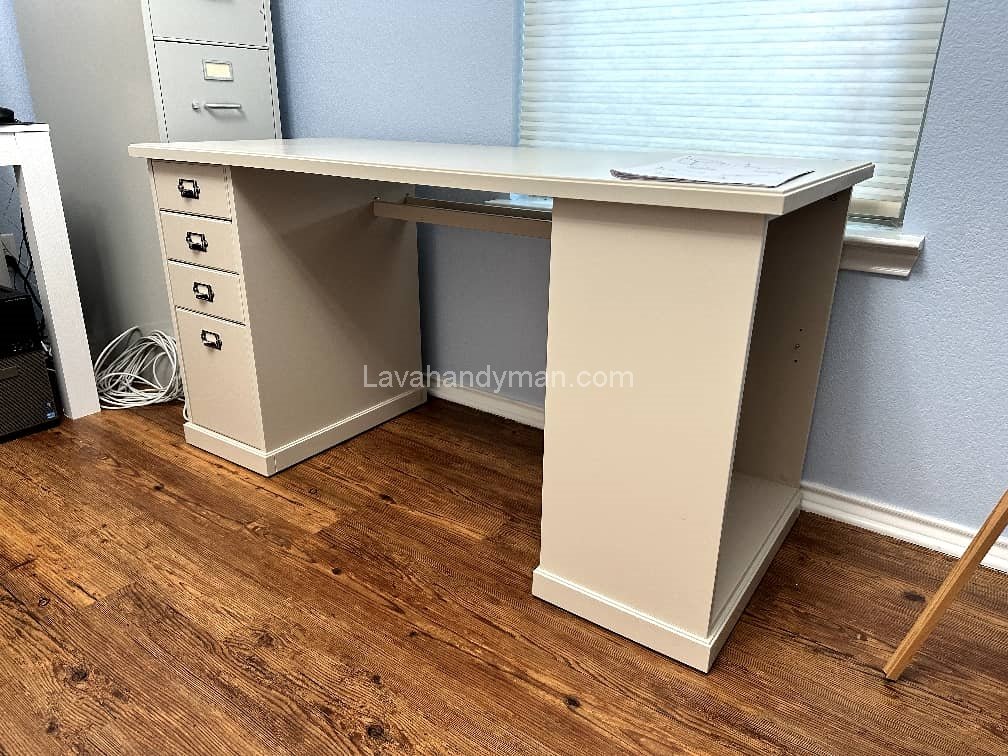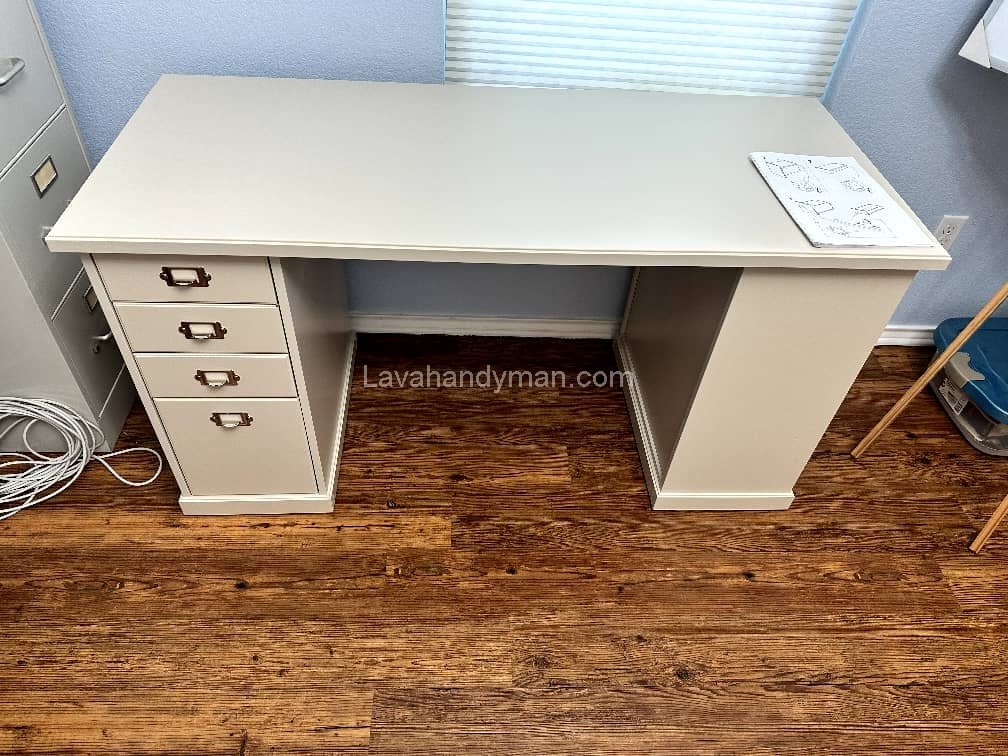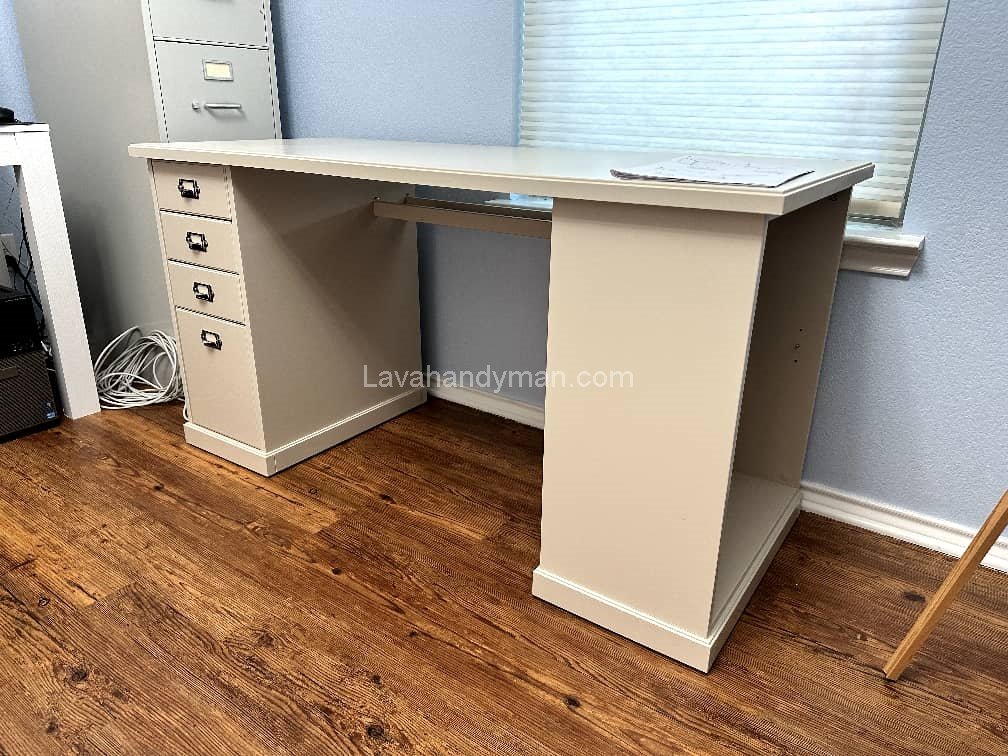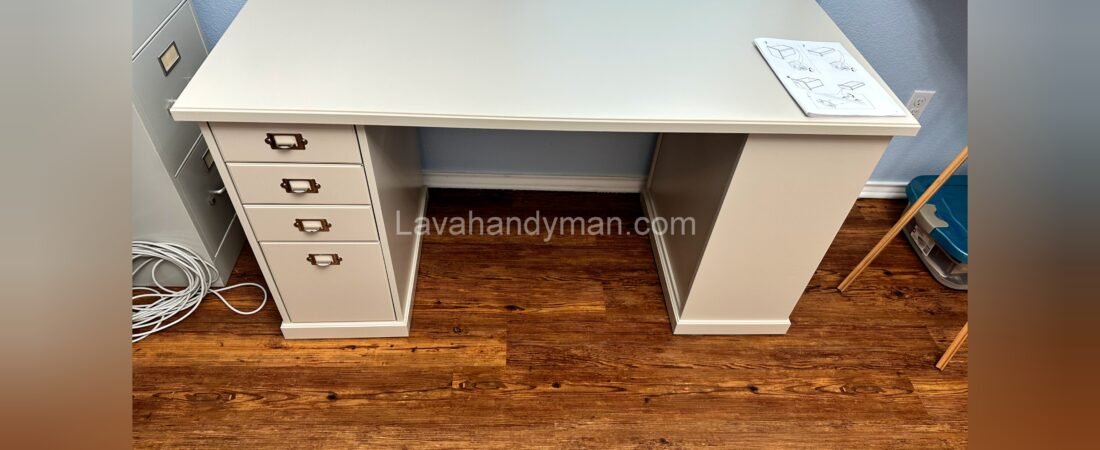Comprehensive Guide to Assembling a Table | Table installation
Introduction
Table assembly is a practical and valuable skill that allows you to create a sturdy and beautiful table using wooden, metal, or other material parts. Tables have various uses, from writing desks to dining tables and computer desks, each with its own design and assembly method. In this article, we will walk you through the step-by-step assembly process, introduce the necessary tools, and teach important tips for building a durable and functional table.

Section 1: Types of Tables and Their Uses
Before starting the assembly, it’s good to be familiar with different types of tables and their applications:
- Writing Desk: Small and suitable for studying, writing, or working with a laptop.
- Dining Table: Larger, designed for meals at home or restaurants.
- Computer Desk: Designed to hold computers and related accessories.
- Conference Table: Large and formal, used for meetings and business gatherings.
- Side Table (Coffee Table): Small and lightweight, used next to sofas or chairs.
Each type of table has its own design and materials that should be considered during the assembly process.
Comprehensive Guide to Assembling a Table | Table installation
Section 2: Materials and Essential Tools
To assemble a quality table, you need the right raw materials and tools:
Materials:
- Wooden boards (MDF, particleboard, natural wood)
- Metal parts (aluminum, steel) for legs or connectors
- Screws, nuts, nails, and wood glue
Tools:
- Screwdriver or electric drill
- Hand saw or power saw for precise cutting
- Hammer for nailing
- Measuring tape and ruler for accurate measurement
- Sandpaper for smoothing edges and surfaces
- Clamps to hold pieces in place during joining
Using appropriate tools will speed up the work and improve quality.
Comprehensive Guide to Assembling a Table | Table installation
Section 3: Step-by-Step Table Assembly
- Preparing the Pieces:
- Precisely cut parts according to the design dimensions
- Sand edges and surfaces to prevent damage and improve appearance
- Attaching the Legs:
- Accurately mark leg positions on the tabletop
- Attach legs with screws, nuts, or suitable glue
- Assembling Drawers or Shelves (if any):
- Carefully put together drawer parts
- Ensure smooth drawer operation
- Final Adjustment and Inspection:
- Level the table using a spirit level
- Tighten all screws and joints securely
- Clean dust and debris from the surface
Comprehensive Guide to Assembling a Table | Table installation
Section 4: Important Tips and Tricks
- Accuracy in Measurement: Even small errors can disrupt the assembly.
- Use Quality Tools: Poor tools reduce work quality and increase the risk of damage.
- Follow Safety Precautions: Wear safety glasses, gloves, and work in a well-lit area.
- Choose a Suitable Workspace: A clean, well-lit, and spacious place helps arrange pieces easily.
Section 5: Common Issues and Suggested Solutions
- Loose Joints: Use high-quality screws, nuts, and appropriate glue to fix the issue.
- Table Unevenness: Adjust legs and use a level to correct this problem.
- Surface Scratches or Damage: Sand gently and apply a protective finish to restore the surface.
Comprehensive Guide to Assembling a Table | Table installation
Section 6: Assembly Differences Based on Material
- Wooden Tables: The most common and easiest to work with; easily cut and shaped.
- Metal Tables: Requires specialized tools like welding equipment or metal drills; very durable.
- Glass Tables: More delicate and needs strong legs and special adhesives.
Each material requires specific assembly methods and care.
Comprehensive Guide to Assembling a Table | Table installation
Essential Tools for Assembling and Installing a Table
Using the right tools is crucial for assembling a sturdy and high-quality table. Below are the key tools commonly used in table assembly:
Wood Glue or Specialized Adhesive
Enhances joint strength and prevents parts from loosening.
Screwdriver or Electric Drill
Essential for driving screws and tightening bolts. An electric drill makes the job faster and more precise.
Hand Saw or Power Saw
For accurately cutting wood or plastic pieces to the desired size and shape. Power saws are especially useful for larger or thicker cuts.
Hammer
Used for driving nails and precisely adjusting parts.
Comprehensive Guide to Assembling a Table | Table installation
Measuring Tape and Ruler
For precise measurement of all parts; accuracy is key to successful assembly.
Sandpaper
To smooth edges and surfaces, removing roughness and splinters.
Clamp
Holds pieces firmly in place during screwing or gluing to ensure stronger joints.
Level (Bubble or Digital)
Ensures the table is perfectly level and prevents unevenness.
Screws, Bolts, and Nails
Basic fasteners to connect different parts securely.
Comprehensive Guide to Assembling a Table | Table installation
Types of Table Materials and Their Characteristics
The material of a table plays a key role in its durability, appearance, functionality, and cost. Choosing the right material based on usage, environment, and style is essential for building a quality table. Below are the most common table materials and their features:
1. Natural Wood
Examples: Oak, Beech, Pine
- Advantages:
- Highly durable and long-lasting
- Warm, natural, and elegant appearance
- Easy to repair, sand, and refinish
- Disadvantages:
- Relatively heavy
- Generally more expensive (especially hardwoods)
- Best for:
- Dining tables, executive desks, luxury furniture
Comprehensive Guide to Assembling a Table | Table installation

2. MDF (Medium Density Fiberboard)
- Advantages:
- Smooth and even surface
- Ideal for painting or applying PVC/laminate
- More affordable than natural wood
- Disadvantages:
- Less durable than solid wood
- Sensitive to moisture and water
- Best for:
- Writing desks, computer tables, modern home furniture
Comprehensive Guide to Assembling a Table | Table installation
3. Particle Board
- Advantages:
- Very budget-friendly
- Lightweight and easy to move
- Can be covered with melamine or laminate
- Disadvantages:
- Low durability
- Weak against moisture and impacts
- Best for:
- Simple, temporary, or children’s desks
4. Metal
Common types: Steel, Aluminum, Iron
- Advantages:
- Extremely strong and durable
- Great for industrial or modern spaces
- Long lifespan
- Disadvantages:
- Can rust if not properly coated
- Sometimes heavy
- Best for:
- Workbenches, office desks, table frames
Comprehensive Guide to Assembling a Table | Table installation
5. Glass
- Advantages:
- Stylish and modern look
- Resistant to heat and stains
- Ideal for bright, open spaces
- Disadvantages:
- Fragile and prone to breaking
- Requires regular cleaning and care to prevent scratches
- Best for:
- Coffee tables, conference tables, reception areas
Comprehensive Guide to Assembling a Table | Table installation
6. Plastic or Resin (Compressed)
- Advantages:
- Lightweight and water-resistant
- Easy to move and low-cost
- Great for humid environments
- Disadvantages:
- Less strong compared to wood or metal
- Simpler appearance
- Best for:
- Outdoor tables, kids’ tables, foldable designs
Conclusion
The best table material depends on your needs, environment, and budget:
For outdoor or high-moisture areas: Plastic or resin
For durability and beauty: Natural wood
For a budget-friendly yet stylish option: MDF or particle board
For industrial or minimalist spaces: Metal or glass
Comprehensive Guide to Assembling a Table | Table installation
Importance and Features of Wooden Tables
Wooden tables are among the most popular choices in interior design, offering a unique combination of natural beauty, durability, and warmth. Whether used in homes, offices, schools, or restaurants, a well-crafted wooden table is a timeless and valuable addition to any space.
Why Are Wooden Tables Important?
- Timeless Aesthetic
Wood has a natural, elegant texture that complements various décor styles—from classic to modern. A wooden table brings a sense of authenticity and nature into the space. - High Durability and Longevity
Tables made from hardwoods like oak or beech can last for years without losing quality. They resist pressure, wear, and everyday use, making them a reliable choice. - Repairable and Restorable
Unlike many other materials, wood can be repaired and refinished. With sanding, staining, or polishing, a wooden table can be renewed and extended in life. - Eco-Friendly Material
When sourced responsibly from sustainable forests, wood is one of the most environmentally friendly materials available. - Visual and Functional Value
Beyond utility, a beautifully designed wooden table enhances the overall aesthetic and perceived value of a room.
Comprehensive Guide to Assembling a Table | Table installation
Key Features of Wooden Tables
- Variety of Wood Types
Woods like oak, walnut, beech, pine, and maple each offer distinct colors, textures, and strength levels, giving you plenty of design flexibility. - Customizability
Wood is easy to shape, carve, cut, or paint, allowing for custom designs tailored to your needs and style. - Warmth and Natural Feel
Unlike metal or glass, which can feel cold or impersonal, wood adds a warm, inviting touch to any environment. - Structural Stability
When properly constructed and maintained, wood resists moderate moisture, temperature changes, and heavy weight effectively. - Great for Material Combinations
Wood blends beautifully with materials like metal, glass, or stone, making it ideal for modern or hybrid designs.
Comprehensive Guide to Assembling a Table | Table installation
Final Tips for Table Assembly
As you complete the table assembly process, paying attention to the final details ensures a solid, long-lasting, and safe result. Here are the key points to keep in mind:
✅ 1. Double-Check All Connections
- Re-tighten all screws, bolts, and joints.
- Make sure the legs are stable and there’s no wobbling or looseness.
Comprehensive Guide to Assembling a Table | Table installation
✅ 2. Ensure the Table Is Level
- Use a bubble or digital level to confirm the tabletop is completely flat.
- An uneven surface can affect usability and damage the table over time.
✅ 3. Inspect for Damage or Scratches
- Check corners and edges for cracks, splinters, or sharp areas.
- If needed, sand rough spots or apply wood polish to remove minor scratches.
Comprehensive Guide to Assembling a Table | Table installation
✅ 4. Final Cleaning
- Wipe off dust, wood shavings, and any glue residue.
- A soft, slightly damp cloth works well for cleaning the surface.
✅ 5. Prioritize Safety
- Ask for help when lifting or moving heavy tables to avoid injury or damage.
- Let any strong adhesives fully dry (typically 24 hours) before use.
✅ 6. Keep the Instruction Manual
- If the table came as a ready-to-assemble kit, keep the manual for future reference—useful for repairs, disassembly, or reassembly.
✅ 7. Place the Table in a Suitable Spot
- Choose a flat, stable surface for placement.
- Avoid direct sunlight or high humidity areas.
- Consider adding felt pads under the legs to protect the floor.
Final Summary
Assembling a table isn’t just about connecting parts—it’s about doing it with care and precision. By following these tips, you’ll ensure a strong, beautiful, and long-lasting table that serves you well for years to come.
Conclusion
Table assembly is a rewarding and creative task with some knowledge and care. By choosing the right materials, using proper tools, and following safety and technical tips, you can build a strong and beautiful table for your home or workplace. This skill not only saves money but also allows for customization and designing a table that perfectly suits your needs.
📞 Need Help?
Let us take care of the hard work while you sit back and relax.
📍 Serving: Austin, Round Rock, Cedar Park & more
📱 Call or Text: (737) 420-6992
🌐 Visit: https://lavahandyman.com


